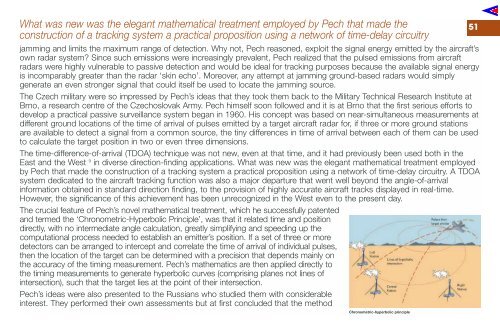Volume 5 No 2 - Royal Air Force Centre for Air Power Studies
Volume 5 No 2 - Royal Air Force Centre for Air Power Studies
Volume 5 No 2 - Royal Air Force Centre for Air Power Studies
Create successful ePaper yourself
Turn your PDF publications into a flip-book with our unique Google optimized e-Paper software.
What was new was the elegant mathematical treatment employed by Pech that made the<br />
construction of a tracking system a practical proposition using a network of time-delay circuitry<br />
jamming and limits the maximum range of detection. Why not, Pech reasoned, exploit the signal energy emitted by the aircraft’s<br />
own radar system? Since such emissions were increasingly prevalent, Pech realized that the pulsed emissions from aircraft<br />
radars were highly vulnerable to passive detection and would be ideal <strong>for</strong> tracking purposes because the available signal energy<br />
is incomparably greater than the radar ‘skin echo’. Moreover, any attempt at jamming ground-based radars would simply<br />
generate an even stronger signal that could itself be used to locate the jamming source.<br />
The Czech military were so impressed by Pech’s ideas that they took them back to the Military Technical Research Institute at<br />
Brno, a research centre of the Czechoslovak Army. Pech himself soon followed and it is at Brno that the first serious ef<strong>for</strong>ts to<br />
develop a practical passive surveillance system began in 1960. His concept was based on near-simultaneous measurements at<br />
different ground locations of the time of arrival of pulses emitted by a target aircraft radar <strong>for</strong>, if three or more ground stations<br />
are available to detect a signal from a common source, the tiny differences in time of arrival between each of them can be used<br />
to calculate the target position in two or even three dimensions.<br />
The time-difference-of-arrival (TDOA) technique was not new, even at that time, and it had previously been used both in the<br />
East and the West 9 in diverse direction-finding applications. What was new was the elegant mathematical treatment employed<br />
by Pech that made the construction of a tracking system a practical proposition using a network of time-delay circuitry. A TDOA<br />
system dedicated to the aircraft tracking function was also a major departure that went well beyond the angle-of-arrival<br />
in<strong>for</strong>mation obtained in standard direction finding, to the provision of highly accurate aircraft tracks displayed in real-time.<br />
However, the significance of this achievement has been unrecognized in the West even to the present day.<br />
The crucial feature of Pech’s novel mathematical treatment, which he successfully patented<br />
and termed the ‘Chronometric-Hyperbolic Principle’, was that it related time and position<br />
directly, with no intermediate angle calculation, greatly simplifying and speeding up the<br />
computational process needed to establish an emitter’s position. If a set of three or more<br />
detectors can be arranged to intercept and correlate the time of arrival of individual pulses,<br />
then the location of the target can be determined with a precision that depends mainly on<br />
the accuracy of the timing measurement. Pech’s mathematics are then applied directly to<br />
the timing measurements to generate hyperbolic curves (comprising planes not lines of<br />
intersection), such that the target lies at the point of their intersection.<br />
Pech’s ideas were also presented to the Russians who studied them with considerable<br />
interest. They per<strong>for</strong>med their own assessments but at first concluded that the method<br />
Chronometric-hyperbolic principle<br />
51
















